How to choose the right butterfly valve (1)
When the butterfly valve is fully open to fully closed, it turns usually less than 90°. The butterfly valve and the butterfly stem itself have no self-locking capability. For the

U-type-flange-butterfly-valve-2
positioning of the butterfly plate, a worm gear reducer must be installed on the valve rod. The use of worm gear reducer can not only make the butterfly plate self-locking, stop the butterfly plate at any position, but also improve the valve performance. The characteristics of industrial special butterfly valve: can withstand high temperature, the applicable pressure range is also high, the nominal diameter of the valve is large, the valve body is made of carbon steel, and the sealing ring of the valve plate uses a metal ring instead of a rubber ring. Large high-temperature butterfly valves are manufactured by welding steel plates, and are mainly used for flue gas ducts and gas pipes of high-temperature media.
Selection:
The butterfly plate of the butterfly valve is installed in the diameter direction of the pipeline. The butterfly valve is simple in structure, small in size and light in weight. It is composed of only a few parts, and can be quickly opened and closed only by rotating 90°. The operation is simple, and the valve has good fluid control characteristics. When the butterfly valve is in the fully open position, the thickness of the butterfly plate is the resistance when the medium flows through the valve body. Therefore, the pressure drop generated by the valve is very small, so it has good flow control characteristics.
If the butterfly valve is required to be used as a flow control, the main thing is to choose the valve size and type correctly. The structural principle of the butterfly

wafer-type-butterfly-valve-with-handle-13
valve is especially suitable for making large-diameter valves. Commonly used butterfly valves are wafer-type butterfly valves and flanged butterfly valves. Wafer type butterfly valve is to use double-headed bolt to connect the valve between two pipeline flanges. Flange type butterfly valve is to use the process of connecting the flange of the valve to the pipeline flange with bolts.
The butterfly valve has been widely used in many fields such as petroleum, chemical industry, metallurgy, hydropower, etc. as a component used to realize the on-off and flow control of the pipeline system. In the well-known butterfly valve technology, the sealing form mostly adopts a sealing structure, and the sealing material is rubber, polytetrafluoroethylene and the like. Due to the limitation of structural characteristics, it is not suitable for industries such as high temperature, high pressure, corrosion resistance and wear resistance.
An existing more advanced butterfly valve is a three-eccentric metal hard-sealed butterfly valve. The valve body and valve seat are connected components. The sealing surface layer of the valve seat is welded with temperature-resistant and corrosion-resistant alloy materials. The multi-layer soft stack type sealing ring is fixed on the valve plate. Compared with the traditional butterfly valve, this butterfly valve has high temperature resistance, is easy to operate, and has no friction when opening and closing. When closing, the torque is compensated with the increase of the torque of the transmission mechanism, which improves the butterfly valve. The sealing performance and the advantages of extended service life.
TH Valve is a professional manufacturer of butterfly valve, gate valve, check valve, globe valve, knife gate valve, ball valve with API, JIS, DIN standard, used in Oil, Gas, Marine industry, Water supply and drainage, fire fighting, shipbuilding, water treatment and other systems, with Nominal Diameter of DN50 to DN1200, NBR/EPDM/VITON, Certificates & Approvals: DNV-GL, Lloyds, DNV, BV, API, ABS, CCS. Standards: EN 593, API609, API6D
Related news /knowledge: How to choose the right butterfly valve (2); Notes on selection and installation of butterfly valve; What is the material of the main parts of the butterfly valve?-(2);



 © Copyright 2020 Tianjin Tanghaidongyang Valve Co., Ltd. All Rights Reserved.
© Copyright 2020 Tianjin Tanghaidongyang Valve Co., Ltd. All Rights Reserved. tanghaivalve.com
tanghaivalve.com